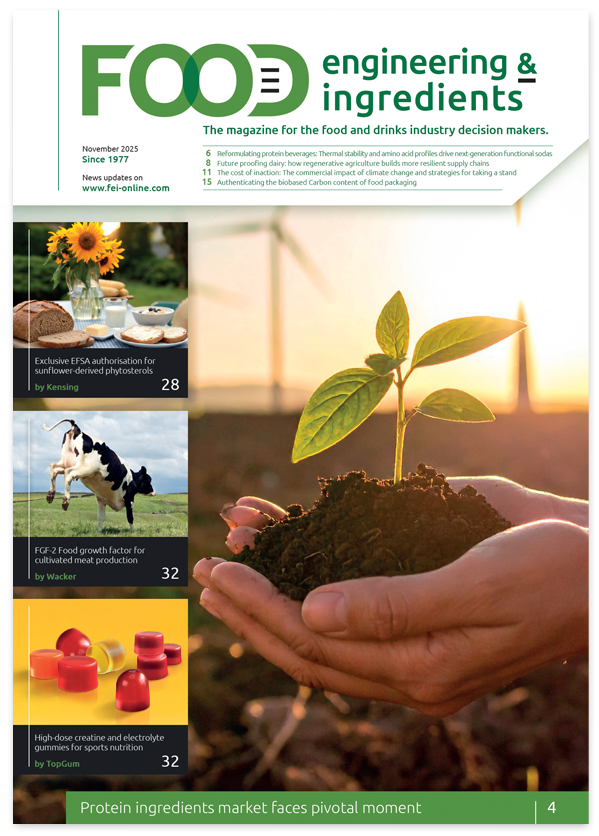Consumer acceptance holds key to upcycled food market viability
EIT Food’s latest Consumer Trends Report exposes critical messaging challenges for upcycled food manufacturers, with European research revealing that environmental support fails to translate into purchasing behaviour when consumers prioritize taste, health, quality and affordability over sustainability claims across four tested positioning strategies.
The global food system generates approximately 8-10% of greenhouse gas emissions annually through waste alone, yet consumer acceptance of products manufactured from surplus ingredients remains a complex challenge for the food industry. Food waste contributes significantly to global greenhouse gas emissions, accounting for approximately 8-10% annually, creating substantial pressure on manufacturers to develop viable upcycled food products that can achieve market penetration.
Recent research conducted by the EIT Food Consumer
Observatory has examined how European consumers respond to different messaging strategies for upcycled food products, revealing fundamental tensions between environmental goals and purchasing priorities. The study examined consumer motivations, concerns, and decision-making drivers for upcycled food products across 30 participants from the Citizen Participation Forum representing 17 European countries.
Strong environmental motivation meets practical purchasing decisions
Consumer attitudes toward food waste reduction demonstrate remarkable consistency across demographics. Participants unanimously expressed dislike of or concern about food waste, with many participants describing childhood-instilled values around preventing waste. “I’m always very careful when it comes to food waste, because I was taught to never waste it,” reported Luca (33), Italy.
The research indicates that reducing food waste is generally seen as an important value that resonates with many consumers, extending beyond environmental consciousness to encompass practical household management strategies. The most common practices consumers use to reduce their food waste are meal planning, freezing leftovers, and prioritising expiring ingredients when cooking.
However, this environmental support encounters significant limitations when translated into purchasing behaviour. Taste, health, quality, and affordability take priority over reduced food waste when consumers make purchasing decisions. This hierarchy creates substantial challenges for manufacturers seeking to position upcycled products primarily on sustainability credentials.
Responsibility for food waste reduction is perceived as shared between industry and consumers, with food manufacturers and supermarkets viewed as having the greatest power to drive impactful change. This perception creates expectations that companies should lead waste reduction efforts while maintaining product quality and affordability standards.
Four positioning strategies reveal messaging complexities
The research tested four distinct narratives for marketing upcycled food products: waste reduction, affordability, healthiness, and taste innovation. Each approach generated both positive responses and specific consumer concerns, highlighting the absence of a universal messaging solution.
Waste reduction messaging proved most effective at creating emotional connections with consumers. Consumers feel a sense of satisfaction when they perceive their actions as making a positive impact on the planet, particularly when environmental impact is clearly communicated. “I love this as I don’t like wasting food and knowing that all parts of a vegetable will be used just makes me happy,” reported Gabriella (37), Hungary.
The approach successfully repositioned waste materials as resources, with consumers appreciating the creative transformation of overlooked ingredients. “I think it’s very interesting to give them a creative reuse, thus maximising the use of these already produced foods,” noted Marco (53), Portugal.
However, sustainability positioning generated concerns about greenwashing and premium pricing. Some consumers are sceptical of “sustainability” labels, suspecting they are used as marketing tactics to justify higher prices despite minimal production costs.
Affordability messaging resonated strongly with consumers seeking value, particularly when products balanced price and quality considerations. “Most appealing for me is the good quality and lower price,” stated Gabriella (37), Hungary. This approach addressed consumer expectations that products using discarded ingredients should naturally have lower price points.
Yet affordability claims faced scepticism about practical implementation. Consumers questioned how companies can balance high quality and affordability in upcycled products, especially when transforming overlooked ingredients is perceived as inherently expensive.
Health-focused messaging attracted consumers seeking nutritious alternatives, particularly for convenient, minimally processed options. “The obvious reason is health benefits. Having something without all the additives is what is needed,” reported Paul (37), United Kingdom. This positioning appealed to consumers wanting healthy alternatives to traditional processed foods.
However, health claims raised concerns about over-processing and artificial additives. Consumers are aware of health issues associated with ultra-processed foods and worry that transforming discarded ingredients might strip them of natural qualities. Additionally, consumers believe healthy upcycled food products will be expensive and therefore inaccessible.
Taste-focused messaging appealed to consumers seeking novel flavour experiences but generated the highest levels of concern. Some consumers doubt that overlooked ingredients can yield flavours that taste good, concerned that waste ingredients will taste less good than traditional ingredients. The emphasis on innovation amplified concerns about artificial additives and food safety.
Persistent barriers challenge market viability
Across all messaging strategies, consistent consumer concerns emerged that may limit market adoption regardless of positioning approach. Quality consistency represents a fundamental challenge, with consumers concerned that using irregular or non-standard raw materials can pose challenges in ensuring consistent taste and quality.
Safety concerns intensify when innovation messaging is emphasised. The notion of innovation in food presents a risk to some consumers, with unconventional products seen as less tried and tested. This perception extends to production practices, where consumers worry about adherence to safety standards for unconventional ingredient applications.
Pricing expectations create additional complications. When positioned as sustainable or healthy products, consumers anticipate premium pricing, yet the use of waste materials suggests lower costs should be achievable. Consumers are divided over price expectations for upcycled foods, with some perceiving them as cheaper due to their association with discarded ingredients, while others see them as too premium when positioned around sustainability and quality benefits.
Processing concerns emerge particularly around health and taste messaging, where consumers associate innovation with artificial additives and extensive processing. Innovating new flavours is associated with chemical additives, making consumers concerned that creating innovative flavours will make food unhealthy.
Strategic implications for industry development
The research findings suggest manufacturers must carefully balance multiple consumer priorities while addressing specific concerns associated with each positioning strategy. Positioning upcycled food products requires balancing a fine line between creating expectation of a healthy, tasty and sustainable product, while addressing concerns raised by these very same expectations.
For waste reduction positioning, manufacturers should emphasise measurable environmental outcomes while maintaining competitive pricing to avoid greenwashing perceptions. Transparency in sourcing and processing methods can help build credibility and consumer trust.
Affordability messaging requires demonstrable quality assurance to overcome scepticism about consistent product standards. Clear communication about ingredient vetting and quality control processes can address concerns about variability in waste-derived materials.
Health positioning demands substantiated claims with minimal processing approaches to counter concerns about artificial additives. Products should emphasise natural transformation methods and provide clear nutritional evidence.
Taste innovation positioning appears riskiest, amplifying concerns about safety, health, and pricing. When pursuing this approach, manufacturers should focus on familiar flavours with subtle enhancements rather than dramatic innovations.
The research indicates no single messaging strategy provides universal appeal, suggesting manufacturers may need segmented approaches targeting specific consumer groups based on their primary motivations. Success will likely depend on addressing the fundamental tension between environmental benefits and traditional purchasing priorities while maintaining transparent communication about production methods and pricing rationale.
The findings highlight that while consumer support for food waste reduction is strong, translating this support into purchasing behaviour requires careful navigation of quality, safety, pricing, and processing concerns that vary significantly across different positioning approaches.




